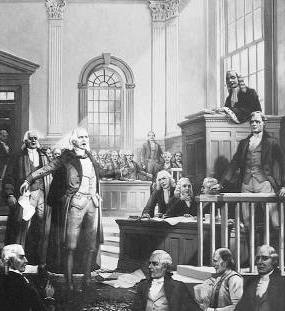

The governor of New York secured an indictment of seditious libel against John Peter Zenger for publishing articles criticizing him. At this time in history and based on English common law, truth was not a defense for libel. But after a compelling defense by Andrew Hamilton, a jury acquitted Zenger. Many consider this case to establish a principle that is now embedded in U.S. law that truthful information cannot be libelous. (Courtroom sketch depicting the trial of Crown v. John Peter Zenger, public domain).
The trial of John Peter Zenger (1697–1746) was one of the most important events in shaping American thinking toward freedom of speech prior to and after the adoption of the First Amendment.
Zenger, born in Germany, immigrated to America at a young age. He was apprenticed to New York’s only printer, William Bradford, after Zenger’s father died. Zenger then went into publishing on his own. After a lawsuit resulted in providing the colonial governor, William Cosby, half the salary of the previous acting governor, Zenger published the dissent of Judge Lewis Morris in pamphlet form.
After Cosby fired Morris and replaced him with James Delancy, an opposition party, the Morrisites, formed and commissioned Zenger to publish the New York Weekly Journal. It contained strident articles and mock advertisements criticizing Cosby. Cosby in turn sought indictments against Zenger for seditious libel, which he eventually secured through “information” after grand juries rebuffed him. An agent of the governor subsequently burned copies of the Weekly Journal in front of city hall. Through instructions to his wife, Zenger would continue publishing his paper during the eight months that he awaited trial in jail.
Chief Justice James Delancy disbarred James Alexander and William Smith who stood ready to defend Zenger at his April 1735 trial after they questioned Delancy’s authority to preside. After John Chambers, a court-appointed attorney, presented the opening argument, Andrew Hamilton, a noted Philadelphia attorney (and designer of the building that is today known as Independence Hall), intervened on Zenger’s behalf.
At the time, English common law, which had been transported to the colonies, provided that truth was no defense to an accusation of seditious libel; indeed, truthful information could be even more dangerous than lies, because it was more believable. Calling essentially for the exercise of what today would be considered jury nullification, in the case of New York v. John Peter Zenger Hamilton urged jurors to strike down this law as unjust. Jurors ignored the judges’ instructions and acquitted Zenger to the great delight of onlookers.
Gouverneur Morris, a major figure at the Constitutional Convention of 1787 and a descendant of Judge Lewis Morris, later described Zenger as “the germ of American freedom, the morning star of that liberty which subsequently revolutionized America” (McManus 1999: 914). The importance of the case is that it established the principle, now firmly embedded in U.S. law, that truthful information cannot be libelous. Alexander Hamilton used this argument in the case of People v. Croswell (N.Y. 1804) when defending Harry Croswell against charges of criminal libel for accusations that he had made about President Thomas Jefferson. The concept was later incorporated into the law of New York and other states.
John Vile is a professor of political science and dean of the Honors College at Middle Tennessee State University. He is co-editor of the Encyclopedia of the First Amendment . This article was originally published in 2009.